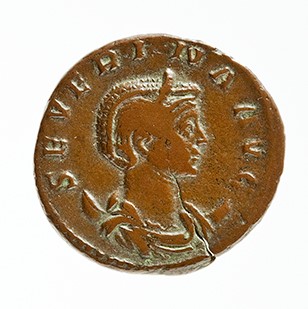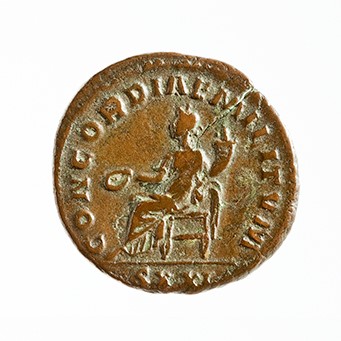Acquisition number: 1968.18
Obv.: Bust of Severina r., diademed, draped, plait of hair up back of head and over crown; crescent behind her shoulders. SEVERINA AVG(usta).
Rev.: Concord seated l., draped, with cornucopiae in left hand and patera (shallow dish for offerings) in right. CONCORDIAE MILITVM. In exergue, S XXI.
Title: Antoninianus of Severina, reign of Aurelian - 1968.18
Acquisition number: 1968.18
Author or editor: Beryl Rawson
Culture or period: Roman Imperial
Date: c. AD 275
Material: Metal - Copper-silver alloy
Object type: Coins - Roman
Dimensions: 20mm (w)
Origin region or location: Hungary
Origin city: Siscia
Display case or on loan: 7
Keywords: Coin, antoninianus, Roman, Imperial, Severina, Aurelian, Concord, Pannonia, Siscia
See Mattingly, H., E.A. Sydenham, C.H. Sutherland, R.A. Carson, The Roman Imperial Coinage 13 vols (London, Spink, 1923-1994) V Part.1, 1 (CONCORD MILITVM, (officinal / mint marks BL, DL etc), and See Sear, D.R., Roman Coins and their Values 5 vols (London, Spink, 2000-2014) 11701 (CONCORD MILITVM and Concord seated l., with cornucopiae and patera ) and Sear 11705/6 (CONCORDIAE MILITVM) and Concord standing with standards in each hand.
Reece, R., Roman Coins (London, Ernest Benn, 1970) 42 and ch. XIX.
1968.18
Antoninianus of Severina, reign of Aurelian
3.655 g. c. AD 275
Obv.: Bust of Severina r., diademed, draped, plait of hair up back of head and over crown; crescent behind her shoulders. SEVERINA AVG(usta).
Rev.: Concord seated l., draped, with cornucopiae in left hand and patera (shallow dish for offerings) in right. CONCORDIAE MILITVM. In exergue, S XXI.
The present coin shows well the debased state of the ‘silver’: the wash has worn off, revealing the basically bronze alloy beneath. The coins of Severina are the last common antoniniani struck for a woman.
Aurelian (Lucius Domitius Aurelianus) was proclaimed emperor by the Roman army which he commanded in his native Illyria (the Balkans) in AD 270. He had recovered considerable territory for Rome and strengthened various frontiers before he was murdered in AD 275.
He reorganised the Roman currency, and the XXI on this coin is one of the marks of value which he introduced. This mark is believed to stand for XX = I, i.e. 20 antoniniani = 1 aureus (the gold coin). See Mattingly and Sydenham V.1 5-15. This mark indicates the later period of the reign. Mint marks were systematised by Aurelian, probably to identify the issuer of any coins and thus guard against counterfeits (a particular danger with such a debased form of coinage). The S on this coin identifies the minting city as Siscia (in Pannonia, modern Hungary), whose mint was opened c. AD 259, when this area became the centre for the military effort to defend the northern-central frontier.
Ulpia Severina was Aurelian’s wife. Her coinage belongs only to the later period of Aurelian’s reign, and it has even been suggested (Mattingly and Sydenham 253) that these coins were struck in her name during the interregnum before the accession of M. Claudius Tacitus. Like all the later coinage of Aurelian, Severina’s coins show little variety on their reverses. (Mattingly and Sydenham, 252, suggest that this may be ‘the first numismatic indication of the growth of that centralization and bureaucratic control which was both the strength and weakness of the later centuries of the Roman empire.’) Most of her reverses are dedicated to Concord. The present reverse legend, ‘Concord of the soldiers’, seems to have been her latest and may have been especially appropriate to a time of military tension and uncertainty.
See Mattingly, H., E.A. Sydenham, C.H. Sutherland, R.A. Carson, The Roman Imperial Coinage 13 vols (London, Spink, 1923-1994) V Part.1, 1 (CONCORD MILITVM, (officinal / mint marks BL, DL etc), and See Sear, D.R., Roman Coins and their Values 5 vols (London, Spink, 2000-2014) 11701 (CONCORD MILITVM and Concord seated l., with cornucopiae and patera ) and Sear 11705/6 (CONCORDIAE MILITVM) and Concord standing with standards in each hand.
Reece, R., Roman Coins (London, Ernest Benn, 1970) 42 and ch. XIX.

